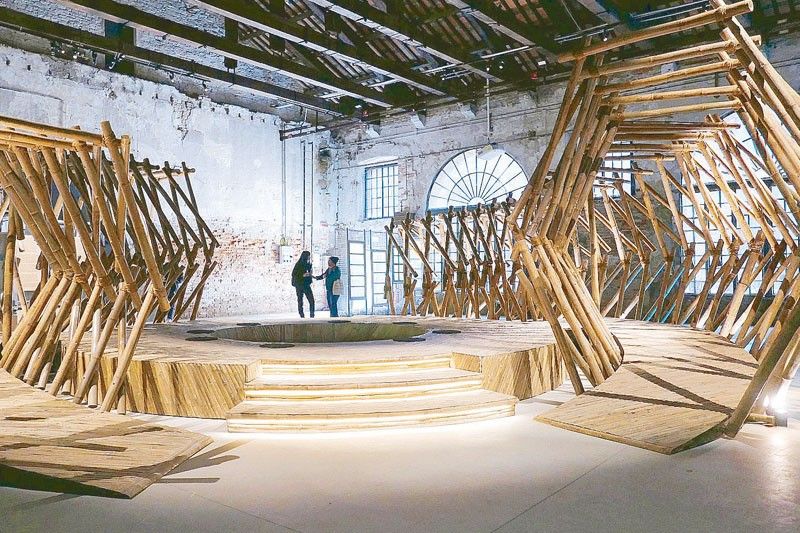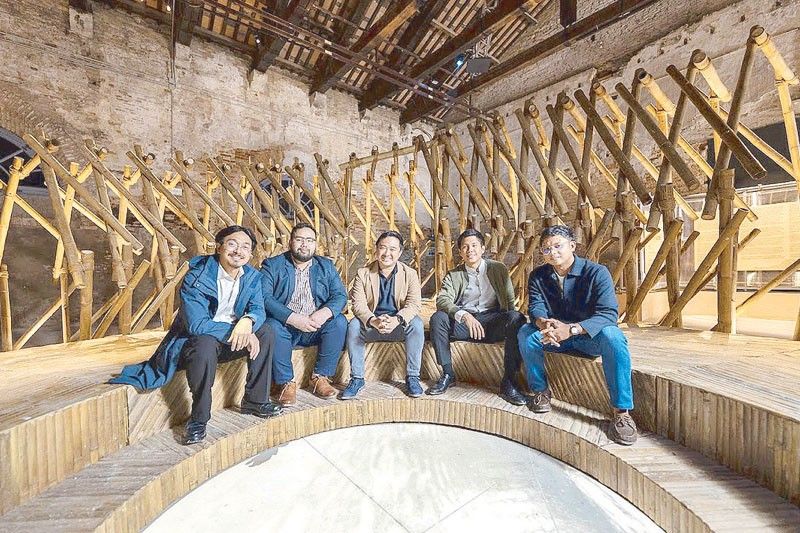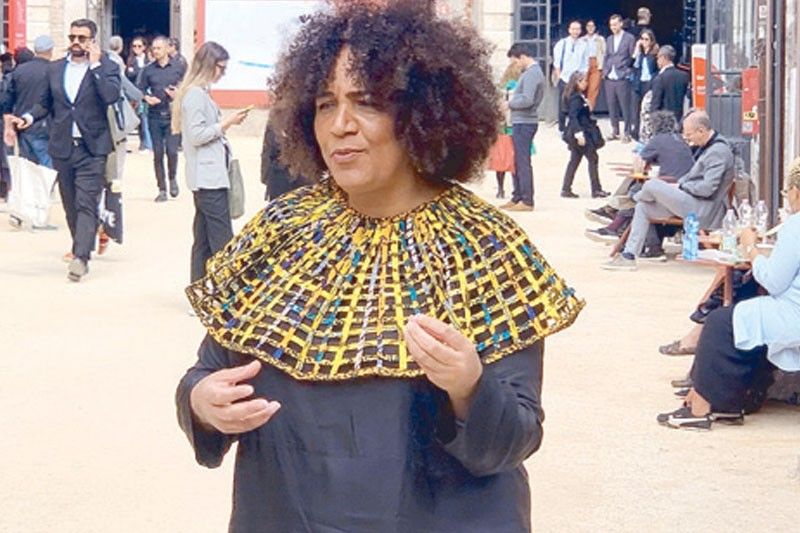Estero stories: PHL Pavilion makes gutsy move @venice architecture biennale

VENICE, Italy — If you asked Midjourney to forward-slash describe curator Lesley Lokko — an architect, academic and novelist — by prompting it with a photo of her taken two days before Biennale Architettura 2023 opened to the public last May 20, the AI program would answer with this: “An African (Ghanaian-Scottish, to be precise) lady in a black dress, (standing) in front of a brick building in the style of the Florentine Renaissance (not sure about that), joyful and optimistic, wearing a black dress with yellow neckpiece and metalwork jewelry made of cheese.”
How Lokko speaks is as literary as that randomly magic-realist AI description. (“Scotland was shiver; Ghana was sweat,” the woman who moved between worlds once told The New York Times.)
“When I first started writing fiction, my agent said, ‘Don’t think what your readers will think. Because if you do, you will lose your voice, your authenticity,’” the curator explained, as we chanced upon her during an interview with the press near the Arsenale, which houses the Philippines’ national pavilion. It is the same way with her curatorial approach to the Venice Architecture Biennale with its theme “The Laboratory of the Future.” Lokko wanted to address the widest possible range of what can be considered as architecture. “It is an exhibition of the broadest field, and not about the building of buildings per se.”

Two men in drag conversing, putting on accessories, interacting with visitors (French Pavilion), check. A deconstructed basketball court as a symbol of decolonization (Mexican Pavilion), swoosh. A grocery store with items bearing brand names such as “Hybrid Landscapes” and “A Spatial Model” (Latvian Pavilion), tagged. Everything from “past trauma to future visions” — with mental constructs in between — can be seen in the spaces at the Arsenale and Giardini. Sometimes, you see one of the installations and wonder what it has to do with architecture — everything and nothing, as it turns out. Art Focus Now even comments how “remarkable that so many countries saw this Architecture Biennale as a place not to show any architecture.”
But aren’t narratives architectural in the first place?
Lokko was asked, “Why do you think that a kind of storytelling is present in the exhibitions across the Biennale?” Her answer: “I think all cultural output is a form of narrative. Somebody said that culture is the sum total of stories we tell ourselves about ourselves.”
She also shared with The Guardian that since her curation of the biennale leans heavily on participants from often-marginalized Africa or the African Diaspora (a departure from the usual Eurocentric editions of the biennale), she is “not trying to say that the story of architecture as usually told is wrong, but it’s an incomplete story.”
So, what is the story or the stories being told in our own pavilion? The exhibition is titled “Tripa de Gallina: Guts of Estuary” by The Architecture Collective (TAC), composed of Bien Alvarez, Matthew Gan, Architect Lyle La Madrid, Noel Narciso and Arnold Rañada. It is co-curated by Architect Choie Y. Funk and Sam Domingo. The hardworking members of the Philippine Arts in Venice Biennale (PAVB) — coordinating committee head Riya Lopez with Mapee Singson and Jeanne Severo — did their absolute best in making sure the pavilion could go toe-to-toe with the others in the biennale.
And the story revolves around water. Curiously, seven other national pavilions take on a similar issue, namely Argentina (“El Futuro del Agua”), Denmark (“Coastal Imaginaries”), Egypt (“NiLab – The Nile as Laboratory”), Greece (“Bodies of Water”), Grenada (“Walking on Water”), The Netherlands (“Waterworks”), and Panama (“Panama: Stories from beneath the water”).
Ours centers on the “bituka ng manok” (chicken entrails): the Estero Tripa de Gallina that veins across Metro Manila serves as a tributary among larger bodies of water in the area. And what was intended as a channel to mitigate flooding has turned into something ecologically monstrous — a repository of human detritus, with kids probably shouting “Kobe!” as they hoist the day’s dregs into the blackened waters in the dying seconds of an imagined playoff game. But as tides turn brackish and time starts to run out, there is still a rippling of hope.

“An estero’s unhampered flow symbolizes life and sustenance inasmuch as its stagnant waters reeking of trash convey disease and death,” explains Senate President Pro Tempore Loren Legarda, who is the project visionary and driving force of the Philippine participation in the Venice Biennale.
Senator Legarda continues, “Our ‘Tripa de Gallina: Guts of Estuary’ exhibition highlights the critical role of esteros in communities as a symbol of life, an essential element for human activities and practices, and a catalyst for community development. It stresses the importance of establishing a relationship with water, a vital resource becoming increasingly scarce. Additionally, the exhibit has been carefully curated to address the pressing issue of waste management and its impact on the community.”
National Commission for Culture and the Arts (NCCA) chair and Philippine Pavilion commissioner Victorino Manalo says, “Through the exhibition, the world will have the opportunity to understand the realities faced by Filipinos and realize that this issue is something that they, too, are facing, potentially cultivating more in-depth and meaningful discussions that lead to collective action and a more sustainable future.”
What started as a De La Salle-College of Saint Benilde project for the Global Summer School in 2018 and 2019 (spearheaded by the Institute for Advanced Architecture of Catalonia in Barcelona, Spain), developed into a study of the communities in Barangays 739, 750 and 751, which are living alongside the metropolis’ longest estuary that flows to Manila Bay through the Pasig River, as the structure underwent different iterations and changes in context (what with the pandemic and all), has now been transformed into an installation in the Arsenale.
The centerpiece at the Philippine Pavilion is a massive bamboo structure (composed of hexagons, footbridges, and a central space that goes above the estero itself), ambiently and dramatically lit and accompanied by video footage of lapping waters and waterway activities projected from the ceiling down into the eye of the structure itself — like a magical well filled with oracular waters that show images of the past and the future, a page out of our forgotten folk tales. (Props to whoever thought of that in the first place.)
The aim of this structure is to create a space where residents can gather and do communal activities — everything from fiestas to wakes, from selling wares to make ends meet, to playing games to pass the time. By the biennale’s end, the ideal scenario would be for it to be shipped back to Manila, retrofitted, and be utilized as it was originally intended: an encapsulation of public space acupuncture.
Imagine: this entire thing originated in the esteros of Manila, found its way across the storied canals of Venice, displayed, to be eventually dismantled, boxed and sent sailing back to whence it came.
“Architecture, tell me who you want to be…” as sung in an aria in the Uruguayan Pavilion as part of an opera of future scenarios. For the guys from TAC, architecture is a means of conjuring space for laro, kain, tambay at tagpuan. And for the people whose lot is to live beside the estuary — who possess humble yet heroic stories of their own — if this is architecture, then it is everything.
* * *
The Philippine participation at the 18th International Architecture Exhibition – La Biennale di Venezia is a collaborative undertaking of the National Commission for Culture and the Arts (NCCA), the Department of Foreign Affairs (DFA), and the Office of Senate President Pro Tempore Loren Legarda.
The Philippine Pavilion will also be made accessible through its digital programs and virtual tours, which will be accessible to the public, anywhere in the world. For information, visit philartsvenicebiennale.org. See updates on Facebook and Instagram via @philartsvenice.
The Venice Architecture Biennale runs until Nov. 26.



















